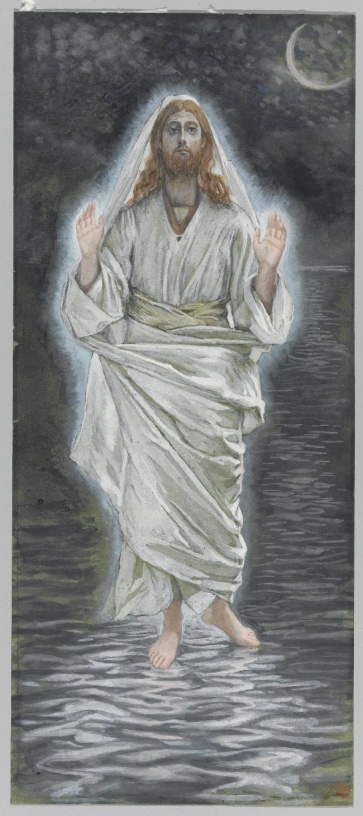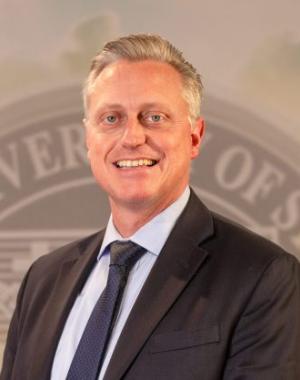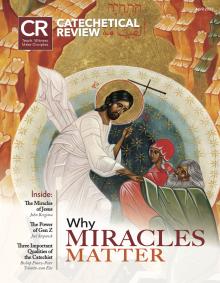 One of the most characteristic features of Jesus’ earthly ministry was his performance of miracles, particularly healings and exorcisms. A typical description of this can be found in Mark 1:34: “he healed many who were sick with various diseases, and cast out many demons.” Jesus’ ability to perform supernatural works made him one of the first “celebrities” of world history; he “could no longer openly enter a town . . . people came to him from every quarter” (Mk 1:45). The miracles served as tangible evidence to his contemporaries that supernatural power was at work in Jesus. Jesus himself pointed to his miracles as evidence to support faith in him: “Believe me that I am in the Father and the Father is in me; or else believe me for the sake of the works themselves” (Jn 14:11).
One of the most characteristic features of Jesus’ earthly ministry was his performance of miracles, particularly healings and exorcisms. A typical description of this can be found in Mark 1:34: “he healed many who were sick with various diseases, and cast out many demons.” Jesus’ ability to perform supernatural works made him one of the first “celebrities” of world history; he “could no longer openly enter a town . . . people came to him from every quarter” (Mk 1:45). The miracles served as tangible evidence to his contemporaries that supernatural power was at work in Jesus. Jesus himself pointed to his miracles as evidence to support faith in him: “Believe me that I am in the Father and the Father is in me; or else believe me for the sake of the works themselves” (Jn 14:11).
Interestingly, even Jesus’ critics did not dispute the fact that he performed miracles but rather offered a different interpretation of how he was able to perform them: “He is possessed by Be-el’zebul, and by the prince of demons he casts out the demons” (Mk 3:22). The Jewish historian Josephus, a contemporary of St. Paul who survived the destruction of Jerusalem in AD 70 and went on to write multiple volumes about Judaism in the first century, includes a description of Jesus’ ministry in which he accepts the Lord’s miracles as historical fact: “Now, there was about this time Jesus, a wise man, if it be lawful to call him a man, for he was a doer of wonderful works . . . He drew over to him both many of the Jews, and many of the Gentiles. He was [called the] ‘Christ.’”[1]
Dismissing Miracles
Of course, since the Enlightenment, Western scholars have attempted to dismiss the miraculous elements of Jesus’ ministry by various arguments, proposing that his healings were psychosomatic cures induced by the power of suggestion, and the exorcisms merely psychological disorders resolved in a similar way. Over a decade ago, I was attending a conference of professional biblical scholars in which one academic got up and read a paper arguing that Jesus’ contemporaries were gullible because they did not understand the concept of natural law. They lived in a kind of fantasy world where gods could walk among men, magic was real, and the miraculous was common. Therefore, some people easily attributed miraculous power to Jesus and others quickly believed it. After his paper was over, I raised my hand and proposed a different perspective: clearly Jesus’ contemporaries did grasp the basic principles of the “laws of nature,” even if they did not use that exact term, because otherwise they would not have been fascinated with Jesus. In the Gospels, Jesus’ actions create a sensation among the populace precisely because people did understand that it was very rare for diseases to spontaneously disappear or for demonic possession to quickly abate. If ancient people did live in a mental fantasy world of magical thinking, as this scholar proposed, Jesus’ miracles would offer no proof of his divinity. His contemporaries would have responded to his wonder-working by saying, “Big deal! This kind of thing happens all the time!” Instead, their reaction was shock: “they were all amazed and glorified God, saying, ‘We never saw anything like this!’” (Mk 2:12). Needless to say, the scholar didn’t appreciate my comment!
The men and women who lived in the ancient world and witnessed the earthly ministry of Jesus were, by and large, sensible people who had a good grasp of the regularities of nature because most of them earned their living by working out in nature every day. They were open to the possibility of the miraculous, to be sure, but also knew it was quite uncommon and rarely experienced. That view of the world is reflected in the writings of ancient historians like Josephus, Tacitus, and Pliny the Elder.
Interestingly, modern people are not as closed to the idea of miracles as we are commonly led to believe by the media and the academy. A recent survey of American medical professionals—by all accounts a highly educated demographic in our culture—found that approximately 76 percent believed in a God and the possibility of miracles.[2] Belief in God is also increasing within the scientific community, with a supermajority of young scientists (66 percent) reporting some kind of theistic belief.[3] Why is this? One contributing factor is the increasing availability of well-documented and, in some cases, highly publicized accounts of the supernatural. For example, the Indianapolis Star (the state capital’s paper of record) documented the 2013 exorcism of Latoya Ammons and her children.[4] Ammons and her mother, who were raising Ammons’ two young sons in the suburbs of Indianapolis, observed strange behavior and paranormal activity in their house. A notable event in the saga was when the boys were brought to the local hospital, where—in the presence of their mother and grandmother, a nurse, a social worker, and perhaps others—both boys walked up the wall of the triage room, stood on the ceiling, and then jumped from the ceiling to the floor. The family eventually found relief through the ministry of Fr. Michael L. Maginot of the Diocese of Gary. The point is, the healing ministry of Christ, including his exorcistic power, still continues to be practiced by the mystical Body of Christ, especially through the work of his anointed ministers, those in Holy Orders.
The Meaning of Miracles
Returning to the miracles of Christ as recorded in the Gospels, we should ponder their theological meaning within the overall message of the New Testament Scriptures. The miracles, first of all, offered empirical evidence to Jesus’ contemporaries that, at the least, God was at work in Jesus and that Jesus was sent by God—in other words, that he was a prophet. This is what Nicodemus means when in the Gospel of John he calls Jesus a “teacher come from God” and asserts that “no one can do these signs . . . unless God is with him” (Jn 3:2).
But some of Jesus’ signs exceeded even those performed by Israel’s ancient prophets. In Mark 2:5–12, Jesus not only heals but forgives sin—something done by no prophet, not even the great ones like Moses or Elijah. The Pharisees rightly respond, “Who can forgive sins but God alone?” (v. 7). Likewise, Jesus’ divine dominion over creation is demonstrated when he calms the storm on the Sea of Galilee (Mk 4:35–41). The disciples rightly respond, “Who then is this, that even wind and sea obey him?” (v. 41). In Israel’s Scriptures, God alone is sovereign over the sky and sea (Ps 107:25). In ancient paganism, the wind was controlled by the chief deity, Jupiter/Zeus, and the sea by his close brother, Neptune/Poseidon. To interpret Mark 4:35–41 properly, we need to take these facts into account: Jesus has just performed the action of the God of Israel, demonstrating superiority to the chief gods of the Gentile pantheon! Yes, Moses and Elijah performed miracles over nature, but only by following God’s instructions (Ex 14:16) or praying to God (1 Kgs 18:36–38). But Jesus issues direct commands (Mk 4:39). Thus, the miracles are evidence not simply of Jesus’ status as prophet but specifically of his divinity.
The “Greater Works” of Today
Finally, it is crucial for us as Catholics to recognize that, as mentioned previously, the miraculous power of Christ unleashed from his physical body in his earthly ministry is still available to us today. That same power is unleashed from his mystical Body, especially in the sacraments. All the Gospels tell the stories of the Lord’s miracles in such a way that we can see connections to the sacraments, but nowhere is it clearer than in the Gospel of John. For example, John recounts the miracle at Cana (Jn 2:1–11) such that the connection to the Eucharist is unmistakable. How could readers fail to see that, just as Jesus transubstantiated water into wine at a wedding feast, so today, through his ministers, he transubstantiates wine into his blood at the Wedding Feast of the Lamb? To drive the point home, John calls the household workers who come to distribute the wine to the guests not by the usual Greek term douloi, “slaves” but rather diakonoi, “servants” or “deacons” (Jn 2:5). Just as diakonoi came to distribute the wine at the Cana wedding, so in the early celebration of the Mass deacons would distribute the Eucharistic Blood to those present. Likewise, in John 9, who could mistake the similarity between curing a man born in the darkness of blindness through washing in the pool called “Sent” (Heb. Siloam) and curing people born in the darkness of original sin through washing in a pool that represents the One “sent” by the Father? All seven of the mighty “signs” that Jesus performs in the Gospel of John point in some way to one or more of the sacraments. The message of John’s Gospel is that the physical miracles performed on the bodies of Jesus’ contemporaries have found fulfillment in the “greater works” (Jn 14:12) of his ministers: spiritual miracles performed on the souls of believers who receive the sacraments from Jesus’ mystical Body.
Dr. John Bergsma has taught Scripture at Franciscan University of Steubenville since 2004. He has written over a dozen books on the Catholic faith and Scripture, including Bible Basics for Catholics: A New Picture of Salvation History (Notre Dame: Ave Maria Press, 2012). He and his wife Dawn reside in Steubenville, OH, with their eight children.
Notes
[1] Flavius Josephus, The Antiquities of the Jews 18:3.
[2] Farr A. Curlin, et al., “Religious Characteristics of U.S. Physicians: A National Survey,” Journal of General Internal Medicine 20, no. 7 (July 2005): 629–34, https://www.ncbi.nlm.nih.gov/pmc/articles/PMC1490160/; recounted by Fr. Robert Spitzer, “The Latest Scientific Evidence of God and the Soul,” public talk, Napa Institute, Napa, CA, January 21, 2023, https://www.youtube.com/watch?v=KvghlgftwnE&t=191s, see timestamp 0:58–3:30.
[3] Curlin, et al., “Religious Characteristics of U.S. Physicians”; Spitzer, “Latest Scientific Evidence.”
[4] Marisa Kwiatkowski, “The Exorcisms of Latoya Ammons,” The Indianapolis Star, January 25, 2014, https://www.indystar.com/story/news/2014/01/25/the-disposession-of-latoy....
This article originally appeared on pages 7-8 of the printed edition.
Art credit: "Jesus Walks on the Sea" by James Tissot, courtesy of the Brooklyn Museum.
This article is from The Catechetical Review (Online Edition ISSN 2379-6324) and may be copied for catechetical purposes only. It may not be reprinted in another published work without the permission of The Catechetical Review by contacting [email protected]


















